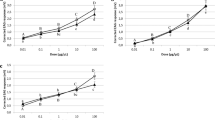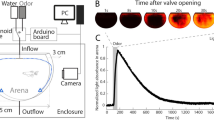Summary
Electro-olfactograms (EOGs) were used to assess olfactory responding by aquatic larval and terrestrial adult tiger salamanders (Ambystoma tigrinum) to airborne volatile compounds, and volatile and non-volatile compounds in aqueous solution. Both forms of salamander showed saturation effects to presentations of airborne stimuli (Fig. 2). Saturation was not observed, however, to stimulus presentations in aqueous solution (Figs. 2, 3). When threshold values and concentration-response curve parameters were compared, non-volatile amino acids in solution were more potent stimuli for larvae while airborne volatiles were more potent stimuli for adults (Tables 1, 2). We infer that metamorphosis in the tiger salamander is accompanied by changes in olfactory response characteristics, due possibly to changes in receptor population, changes in perireceptor properties (e.g. mucus) or to changes in stimulus access.
Similar content being viewed by others
Abbreviations
- EOG :
-
electro-olfactogram
- PPM :
-
(ppm) parts per million
References
Balinski BI (1970) An introduction to embryology. Saunders Co, Philadelphia
Caprio J (1978) Olfaction and taste in the channel catfish: an electrophysiological study of the responses to amino acids and derivatives. J Comp Physiol 123:357–371
Getchell TV (1974) Electrogenic sources of slow voltage transients recorded from frog epithelium. J Neurophysiol 37:1115–1130
Getchell ML, Rafols JA, Getchell TM (1984) Histological and histochemical studies of the secretory components of the salamander olfactory mucosa: Effects of isoproterenol and olfactory nerve section. Anat Rec 208:553–565
Iino M, Takagi SF (1978) Stimulation of the olfactory epithelium with odorants in gaseous and liquid phases. Jpn J Physiol 28:149–157
Margolis SE (1983) Reactions of the olfactory bulb neurons to natural chemical stimuli in the newt (Triturus cristatus). Zool Zh 62:570–579
Ottoson D (1956) Analysis of the electrical activity of the olfactory epithelium. Acta Physiol Scand 35 (Suppl 122):1–83
Pomeranz B (1972) Metamorphosis of frog vision: Changes in ganglion cell physiology and anatomy. Exp Neurol 34:187–199
Poynder TM (1973) Response of the frog olfactory system to controlled odour stimuli. J Soc Cos Chem 5:1–20
Ray AA (1982) Statistical analysis system. User's guide: statistics. SAS Institute, Cary, North Carolina
Reuter T (1969) Visual pigments and ganglion cell activity in the retinae of tadpoles and adult frogs (Rana temporaria L.). Acta Zool Fennica 122:1–64
Shibuya T (1964) Dissociation of olfactory neural response and mucosal potential. Science 143:1338–1340
Shibuya T, Takagi SF (1963) Electrical response and growth of olfactory cilia of the olfactory epithelium of the newt in water and on land. J Gen Physiol 47:71–82
Silver WL (1982) Electrophysiological responses from the peripheral olfactory system of the American eel,Anguilla rostrata. J Comp Physiol 148:379–388
Silver WL, Moulton DG (1982) Chemosensitivity of rat nasal trigeminal receptors. Physiol Behav 28:927–931
Silver WL, Caprio J, Blackwell JF, Tucker D (1976) The underwater electro-olfactogram: a tool for the study of the sense of smell of marine fishes. Experientia 32:1216–1217
Sokal RR, Rohlf FJ (1981) Biometry. WH Freeman, San Francisco
Takagi SF, Shibuya T (1961) Studies on the potential oscillation appearing in the olfactory epithelium of the toad. Jpn J Physiol 13:23–37
Takagi SF, Iino M, Yarita H (1978) Effects of gustatory stimulants upon the olfactory epithelium of the bullfrog and the carp. Jpn J Physiol 28:109–128
Tucker D (1963) Physical variables in the olfactory stimulation process. J Gen Physiol 46:453–489
Tucker D (1975) The role of respiratory ventilation in reliably obtaining electrical waves from olfactory mucosa and nerve in response to odorous stimulation. The 9th Jpn Symp Taste Smell, pp 16–17
Tucker D, Shibuya T (1965) A physiologic and pharmacologic study of olfactory receptors. Cold Spring Harb Symp Quant Biol 30:207–215
Author information
Authors and Affiliations
Rights and permissions
About this article
Cite this article
Arzt, A.H., Silver, W.L., Mason, J.R. et al. Olfactory responses of aquatic and terrestrial tiger salamanders to airborne and waterborne stimuli. J. Comp. Physiol. 158, 479–487 (1986). https://doi.org/10.1007/BF00603794
Accepted:
Issue Date:
DOI: https://doi.org/10.1007/BF00603794




